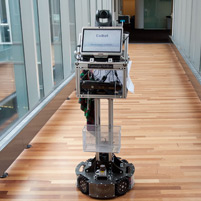Wheeled Wonder

Pay a visit to Manuela Veloso in the Gates and Hillman centers at Carnegie Mellon University and you may be in for a big surprise. Escorting you down the maze of hallways to the professor's office, lab or just about anywhere else in the building, will be one of her CoBots.
Short for 'collaborative robot,' these futuristic service robots can go to a requested location, transport items between locations, and guide people. The CoBot robots autonomously plan to respond to task requests, execute their plans by moving accurately and safely, and follow what Veloso calls novel symbiotic autonomy.
Symbiotic autonomy refers to the idea that while a CoBot can navigate autonomously in indoor environments, it is aware of its perceptual, cognitive and actuation limitations. CoBots, which are armless laptops on wheels, will ask nearby humans for help when stymied, such as when pressing elevator buttons or picking up objects.
Currently, three CoBots offer their help in the Gates and Hillman centers while one works in another nearby space.
Veloso, the Herbert A Simon Professor of Computer Science, who is on sabbatical at New York University, is a leader in artificial intelligence and robotics. She's been studying autonomous robots for more than two decades, also helping to pioneer the field of robot soccer.
Her research on autonomous robots led to her National Science Foundation-funded CoBot project, awarded a few years ago. Symbiotic autonomy — human and robot cooperation — was her solution to the difficulties inherent in creating an autonomous robot able to effectively perform tasks in the uncertain and challenging varied human environments
"Our project is really unique in terms of the true deployment of mobile robots. Under the remarkable work of my students, in particular Joydeep Biswas, Brian Coltin and Stephanie Rosenthal, the CoBot robots have autonomously navigated in the Gates Hillman Centers for more than 400 kilometers," she noted.
Veloso and her team have big plans for their CoBots.
"There are many scientific issues still left to address," Veloso explained. The ongoing research continues to address the increasing in robustness to varied, dynamic environments such as corridor versus open areas, dark/bright areas more or less crowded areas; interaction with people such as speaking, conversing or learning; and task performance using multiple robots, object manipulation, and task interruption.
And their goals extend beyond the science — to helping us in our daily lives.
"We would also like to commercialize our ideas to the point that we would effectively have robots moving and servicing people in public spaces," she said, noting she looks forward to one day working with the university to make this happen.
"CMU is the perfect place to conduct this work because of the outstanding quality of our graduate students," Veloso added in commending her top-notch team. "And also because CMU empowers people to follow real, novel and daring research ideas."
Related Links: NSF article | School of Computer Science | CoBots
